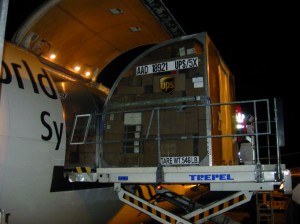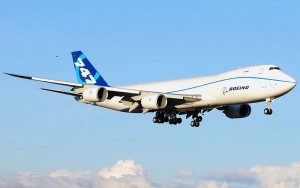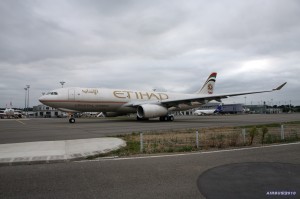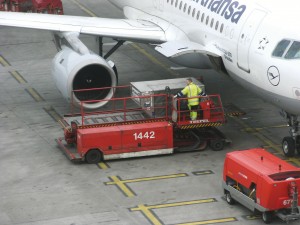As air cargo starts to recover from the recession, Richard Gardner looks at aviation’s most vulnerable sector.
This is a full article published in Aerospace International: December 2010After the worst global economic downturn in decades, world trade, including air cargo, is rising again. The fact that international business activity is undeniably inter-dependent in the 21st century should ensure that the air cargo sector cannot fail as a key aspect of the wealth-creating cycle. But the sector is vulnerable, not only to the impact from up and down market flows, unbalanced traffic patterns and the rising environmental costs of air transport. As recent headline events have shown, air cargo is emerging as the soft underbelly in aviation security — a situation recognised by terrorists, and one that presents challenging difficulties in the fight to keep flying safe for those on the ground as well as in the air.
Boeing’s biennial 20-year air cargo forecast was released on 2 November and describes an industry that has been on the rebound over the past 12 months. The turn-round in fortunes started in November 2009 and has continued so that by the year’s end it is expected to have regained its 2007 peak. Over the next two decades, world air cargo is, according to the forecast, to expand at a 5.9% annual rate and by 2030 will have tripled. “Economic activity — world gross domestic product — is the key driver of the air cargo market,” said Jerry Allyne, vice president strategic planning and analysis, at Boeing Commercial Airplanes. “Following the recession and a year of recovery, world economic growth is forecast to average 3.2% over the next two decades.”
The 2008-2009 period was the first time that air cargo traffic contracted for two consecutive years and this affected nearly all geographic markets. But Boeing’s findings indicate that markets connected to industrial freight flows generally fared worse than markets less dependent on these flows. The nearly 13% drop in cargo traffic in 2008-2009 reflected the steep plunge in industrial activity resulting from the global economic downturn. In August 2009, industrial activity began to recover, particularly in Asia. Monthly air cargo traffic statistics turned positive in November 2009 and the first eight months of 2010 have seen an estimated 24% growth in traffic, compared to the same period last year. In addition to the strong re-bound, anecdotal evidence suggests that individual shippers have turned to air cargo in response to the overcorrection that constrained capacity in other modes of transport, particularly container ships. Allyne said: “Industrial requirements are driving the rebound, as air cargo is an essential tool for industry and commerce to manage supply chains and to bring goods to market. As airlines return to profitability, they will begin to consider fleet renewal to improve long-term operating costs.”
Asian production remains solid, and will grow faster than the global average. Continued growth in China will have positive market effects, as will fewer barriers to international trade. Chinese domestic and intra-Asian markets will grow at 9.2% and 7.9% respectively.
Aerospace International Contents - December 2010
News Roundup - p4
Weakest link - p12
Could security scares hamper predicted air freight growth?
Beyond Darwin - p14
Survival of the fittest - ten ways airlines are evolving
SDSR - what next for airpower? p 18
The UK’s defence budget cuts assessed
Letters - p21
Comments on Shuttle risks and RAF tanker contracts
Dreamtraining - p22
Flight training for the Boeing 787
Spies in the Sky- p26Military surveillance satellites profiled
Brighter skies ahead? - p30
NBAA show report
The last word - p34
RAeS head of research, Prof Keith Hayward assesses defence acquisition reform
New freighters
Looking at what this means in terms of numbers of new aircraft required for replacement and handling growth, Boeing research indicates the world air freighter fleet will increase to 2,967 aircraft (from 1,755) during the next 20 years, with very large freighters ultimately representing 33% of the total fleet, compared to 27% today. This demand will be met by the supply of 743 new-build air cargo freighters and 1,751 conversions from ex-passenger jets and combi-aircraft. Estimated total value is $180bn. Aircraft conversions, always a popular route to acquiring air cargo aircraft in the past, will account for about 70% of the total.
Airbus has not taken its eye off the cargo market either, and its new A330-200F is now in freight service with Etihad and is expected to prove a popular choice offering more capacity than Boeing’s well established 767 family and the now out of production A300-600 and A310 freighters. At the top end of the cargo market, Boeing has the highest capacity slot all to itself with the latest 747-8 in its freight configuration. Somewhat delayed in the development programme, this aircraft is now expected to enter service with Cargolux around June-July next year.
New security threat emerges
The foiled terrorist plot to place two explosive devices aboard two US-bound aircraft at the end of October has caused a major global security review of how air freight is screened and handled. Long regarded by many as a weak link in total airline security, these two incidents, part of a combined plot originating in Yemen, involved two sophisticated bombs, hidden within toner cartridges and travelling unaccompanied. They contained between 300g-400g of PETN, which experts have confirmed would be more than enough to bring down an aircraft if exploded onboard. The devices were thus credible and highly dangerous. There are aspects of these incidents that remain somewhat curious however. If the perpetrators intended them to bring down aircraft, then why did they make them more conspicuous by sending them from a suspicious destination such as Yemen to an overtly Jewish address in the US? Surely the security authorities would have been on their guard against such packages? But it seems they were not. The only reason they were detected was because of a tip-off by a former Al Qaeda terrorist and member of the Guantanamo Bay Old Boys’ Club, who was turned by Saudi counter-terrorism security officials. So was this a serious attempt at a mid-air terror attack that was foiled, or a dry-run for a follow up, and larger-scale, precision attack? Or was it to divert attention from a completely different and as yet unknown plot?
The major global logistics companies that specialise in air freight and package deliveries now offer customers tracking services, so that consignments can be traced en route to their final destinations. This is intended to offer greater security for their items and peace of mind that they will arrive on time without getting lost along the way. Any customer with a PC can trace their consignment’s progress on-line. But it seems possible that the terrorists might have been anxious to benefit from such facilities in order to work out an optimum time to explode the device. A cargo aircraft coming down mid-ocean, perhaps taking its black-box with it, might create limited publicity compared to the same aircraft crashing on approach to, or while overflying, a major city. As airport security measures have made the carrying by passengers of explosive devices increasingly difficult (see p 21 of last month’s issue of Aerospace International) terrorists have clearly identified air cargo as an alternative, perhaps easier, target to achieve their aims. A very worrying aspect of this latest incident is that it highlights the fact that some 60% of air freight is carried aboard passenger aircraft. While those sitting comfortably in the main cabins have been made to pass through intensive security screening before reaching their seats, some of the cargo beneath their feet might have originated at a completely unrelated departure point, where screening is not to the highest standards.
The shock-waves now running through the whole global security community concerning what might have happened at the end of last month is resulting in detailed appraisals of different weak-points and what needs to be addressed as a matter of urgency. Immediate measures to ban packages and air freight from the most suspicious countries that are known to harbour terror groups is a start but already the culprits will be looking at ways around this. In early November the UK Department for Transport announced that various new measures would be taken, including air shipments to be graded according to perceived risk, and Home Secretary, Theresa May MP, also announced that increased passenger profiling techniques, as introduced throughout the US, would be further examined.
Better training at all levels in the aviation security sector are called for. Evidence of how the police and freight operator handled the situation at East Midlands Airport last month is now in the public domain as it has emerged that the identified suspect items were unloaded off the aircraft before the counter-terrorist teams arrived and, even worse, a police helicopter was used to fly away for further examination what turned out to be a bomb but which had not been recognised as an explosive device beforehand. Clearly agreed security procedures and practices concerning every aspect of air cargo operations need re-visiting and improving.
With the latest scanning techniques and equipment now available from specialist suppliers, there is no excuse for aviation security at major air cargo hubs to be inferior to passenger screening. But the situation at smaller airports, especially in countries where there is little will or money to put things right, will remain a major concern if this remains the weakest link in the total security system. Intelligence is currently the best ally of the air transport sector but it is surely unacceptable to over- rely on tip-offs from terrorists who may or may not have changed allegiances. A more robust and comprehensive solution is needed.
This is a full article published in Aerospace International: December 2010. As a member, you recieve two new Royal Aeronautical Society publications each month - find out more about membership.











